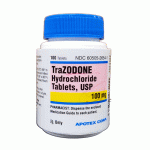The 67-year-old woman was admitted to the emergency department (DE) with erratic behavior, including irritability, agitation, and assault to the extent that she required restraint after being accused of assaulting a police officer. She had hypertension, hyperlipidemia, chronic low back pain, osteoarthritis, and chronic hypokalemia. In the past 2 years, the patient took amitriptyline at a dose of 150 mg per day, prescribed by her doctor. Her other medications (also prescribed by her doctor) included bisoprolol 2.5 mg / day, diltiazem 360 mg / day, pantoprazole 40 mg / day, pravastatin 20 mg / day, and potassium chloride 8 mmol / day.
Obtaining an anamnesis of the patient was difficult, but the concomitant anamnesis of the members of her family showed progressive erratic behavior 2 weeks before her presentation in the emergency department. The behavior began after taking a new medication, trazodone (100 mg / day), which was prescribed by her doctor for insomnia. Since then, she has gradually become irritable, hyperactive, communicative with a clear flight of ideas and uninhibited. She spent large sums of money on unnecessary things, drank excessively for the past 5-6 days (which was unusual for her), and did not sleep at all for the last 3 days before erectile dysfunction, but showed no signs of fatigue. The patient also had the misconception that Jesus sent her messages through a clock, and she believed that she had a special power to end poverty in the world.
There were no reports of an alleged stressor prior to the current episode. The patient had no concomitant diseases, such as coronary heart disease, obstructive airway disease, or endocrine disorders. The patient had no history of traumatic brain injury, migraine, central nervous system infection, or significant medical or mental illness, including mood or psychotic disorder. His family history of mental disorders was also not remarkable.
The patient was hospitalized and trazodone and amitriptyline were discontinued. The Clinical Abstinence Syndrome Protocol (CIWA) was initiated to rule out alcohol consumption and the following tests were performed: complete blood count (CBC) with differentiation, liver and kidney function, bilirubin, lactate, albumin, thyroid function, random glucose and tests for hemoglobin A1c, vitamin B12, and C-reactive protein, all of which were within normal limits. The blood and urine culture was negative. Urine toxicology was positive for tricyclic antidepressants (i.e. amitriptyline). His blood alcohol level was elevated with DE, but he responded well to CIWA and was normal on the third day after admission; The urea and electrolyte levels showed a low potassium level (the lowest level was 2.8 mmol / L), therefore, intravenous potassium administration was started, and its level slowly returned to normal. He had no vomiting or diarrhea, and he did not take any diuretic until he received it. The cause of his chronic hypokalemia was difficult to determine. In addition, computed tomography of the head excluded acute ischemic or hemorrhagic lesions, but revealed a slight loss in the volume of the parenchyma of the frontal lobe.
The mania of a patient with psychosis did not improve on day 4, therefore, a psychiatry consultation was performed. It was evaluated and diagnosed as a secondary manic episode with psychosis caused by a change in medication (starting with trazodone and possibly its amitriptyline), or by organic causes. Intramuscular haloperidol and olanzapine were started to control her arousal. After a slight improvement, a neurologist was consulted to rule out any neurological causes of his condition, including encephalitis. An electroencephalogram and magnetic resonance were performed, but the results were normal.
Although rare, paraneoplastic syndromes were considered as part of the differential diagnosis at the time, because they can affect the central nervous system and lead
